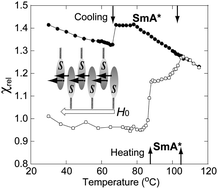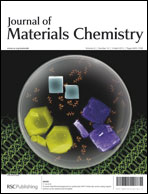Observation of positive and negative magneto-LC effects in all-organic nitroxide radical liquid crystals by EPR spectroscopy†
Abstract
The generation of spin glass-like inhomogeneous magnetic interactions (the average spin–spin interaction constant: ![[J with combining macron]](https://www.rsc.org/images/entities/i_char_004a_0304.gif) > 0 or
> 0 or ![[J with combining macron]](https://www.rsc.org/images/entities/i_char_004a_0304.gif) < 0), which we refer to as positive or negative “magneto-LC effects”, respectively, was observed in the bulk liquid crystalline (
< 0), which we refer to as positive or negative “magneto-LC effects”, respectively, was observed in the bulk liquid crystalline (![[J with combining macron]](https://www.rsc.org/images/entities/i_char_004a_0304.gif) depended on the type of
depended on the type of ![[J with combining macron]](https://www.rsc.org/images/entities/i_char_004a_0304.gif) > 0) operated in the chiral smectic A (SmA*) phase of (2S,5S)-2b (89% ee) than in the chiral nematic (N*) phase of (2S,5S)-2a (96% ee), whereas weak negative interactions (
> 0) operated in the chiral smectic A (SmA*) phase of (2S,5S)-2b (89% ee) than in the chiral nematic (N*) phase of (2S,5S)-2a (96% ee), whereas weak negative interactions (![[J with combining macron]](https://www.rsc.org/images/entities/i_char_004a_0304.gif) < 0) were observed in the achiral nematic (N) phase of (±)-2a. The origin of the positive magneto-LC effects operating in the SmA* and N* phases was interpreted in terms of the generation of ferromagnetic head-to-tail spin–spin dipole interactions, whereas antiferromagnetic interactions arising from the formation of the RS magnetic dipolar interaction were responsible for the negative magneto-LC effects in the N phase.
< 0) were observed in the achiral nematic (N) phase of (±)-2a. The origin of the positive magneto-LC effects operating in the SmA* and N* phases was interpreted in terms of the generation of ferromagnetic head-to-tail spin–spin dipole interactions, whereas antiferromagnetic interactions arising from the formation of the RS magnetic dipolar interaction were responsible for the negative magneto-LC effects in the N phase.


 Please wait while we load your content...
Please wait while we load your content...